In the mineral rich province of Katanga in the Democratic Republic of Congo, cholera has claimed 100 lives. The health workers and affected residents feel that it is hard to put an end to this.
"This disease is satanic!" Annie Masengo, a mother who has just lost one of her six children to cholera in the poor Kenya district of Katanga's capital Lubumbashi, told AFP, saying she could "only pray all the time.""There's no tap water here. We drink rain water. The government distributed chlorine on February 7, but it has already run out and I have no money to buy any" to purify infected water, Masengo said.
Her son of three died because he arrived too late to be saved in one of the treatment centres set up in Lubumbashi by the international aid agency Medecins Sans Frontieres (MSF - Doctors without Borders).
"On average, we're taking in about 60 new cases each day in Lubumbashi and in Likasi," the second most badly affected town, MSF emergency team coordinator Bertrand Perrochet said.
"We can cope with the patients arriving when it comes to medical treatment," Perrochet explained. "But the problem is to bring the disease under control by dealing with its root causes."
In Lubumbashi and Likasi, the foyers of the highly contagious intestinal disease are in the working-class neighbourhoods, where most people have to put up with the appalling hygienic conditions that promote cholera, which kills without treatment.
Advertisement
In one house nearby, Christin Mulage lives with his two wives and 14 children. He presents himself as a "survivor" in his 50s, having just got out of hospital determined in the future to treat his family's water with chlorine.
Advertisement
"We've pointed out that an effort must be made by the national water distribution company (Regideso) to supply the affected areas," said Dr Vital Mundunge, who is the health ministry official in charge of fighting the outbreak."
"This is a big investment and a long-term one. In the meantime, our teams have been reinforced on the ground, launched health awareness campaigns and are distributing water and chlorinated disinfectants for water," Mundunge said.
Albertine Mwambuyu, a 42-year-old trader who comes from neighbouring Kasai Oriental province, complained that these distributions are unfair in the Kenya neighbourhood, where some residents appear to benefit from "connections" with local authorities.
"Me, I don't know anyone. So where's a distribution, I never get anything," Mwambuyu said, adding that she regretted that no records were kept of who got supplied.
Kenya's residents said they have pleaded for a renovation of their water supply for years. "These rotten pipes," one young man burst out. "They haven't been redone since the Belgians went."
Belgian colonisation of the country ended in 1960.
Source-AFP
KAV/K








